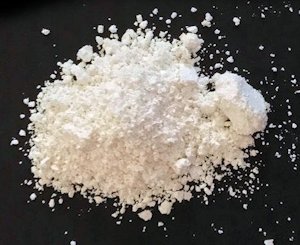
MDPHP powder
![]()
Cathinone
Known on the street as 'Monkey Dust'
![]()
![]()
Molecule of the Month September 2018
Also available: HTML version.
![]()

BBC News article (August 2018)
 MDPHP powder |
CathinoneKnown on the street as 'Monkey Dust'
Molecule of the Month September 2018
|
 BBC News article (August 2018) |
It’s called MDPHP, but its street name is 'Monkey Dust'. It’s a new designer drug that’s been creating a media stir recently.
It's a drug that has been synthesised in a lab by a chemist, usually by taking an existing drug and chemically altering it by adding or removing sidegroups.
When the dangers of new recreational drugs are discovered, they are often banned by the government. But this banning procedure can take months or even years to pass through legislation, and in the meantime the drug is legal, and causing chaos on the streets. Once it is banned, a street chemist can rapidly change the chemical structure of the drug molecule in such a way that the potency is not affected (or maybe even enhanced), but sufficiently so that it is classed as a completely different molecule not subject to the ban. The new drug then has another long period of freedom before the legal system eventually recognises and outlaws it.
The skeleton is based upon the molecule cathinone, which is an alkaloid extracted from the shrub Catha edulis (known colloquially as khat). It is chemically similar to many amphetamines [MOTM March 2007], and so has a similar stimulant effect – the ‘high’ that addicts crave.

Man eating khat
[By Ferdinand Reus from Arnhem, Holland
[CC BY-SA 2.0], via Wikimedia Commons]
Yes, it’s been around for thousands of years, and the plant is commonly chewed by people in Africa and Arabia for its euphoric effect. It contains 2 main compounds, cathine and cathinone, with the latter being the psychoactive ingredient. In countries like Ethiopia, Kenya and Yemen, khat is chewed to reduce hunger or fatigue, especially by students and long-distance drivers who use it to stay awake for longer periods, and is often called 'The Flower of Paradise'. It is often chewed as a social drug, and is popular because in Islamic countries it offers a high that is not forbidden by the Koran. However, khat is illegal in the US, UK, China and most EU countries, but is still legal in quite a few African and Arabian ones.
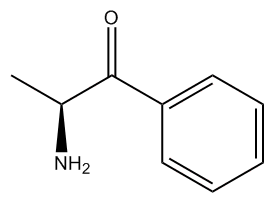 |
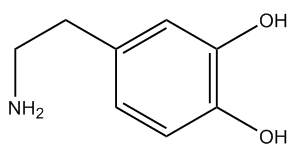 |
| Cathinone | Dopamine |
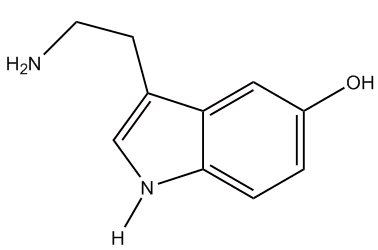 |
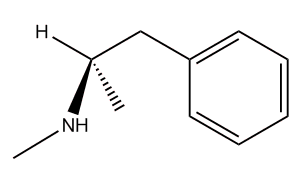 |
| Serotonin | Methamphetamine |
Cathinone is hydrophobic, so it can readily pass from the bloodstream through cell membranes into cells, or cross the blood-brain barrier. Its structure is very similar to that of natural neurotransmitters, such as dopamine [MOTM Oct 2008], serotonin [MOTM April 2005], adrenaline [MOTM May 1999] and noradrenaline, in that it consists of an aromatic ring separated by 2 carbons from an amine. Thus, cathinone can bind to the same neuroreceptors in the central nervous system, and when it does so it stimulates the release of dopamine and inhibits uptake of serotonin, adrenaline and noradrenaline. These alterations to the neurotransmitter concentrations in the brain cause the euphoria and mood changes that the user desires.
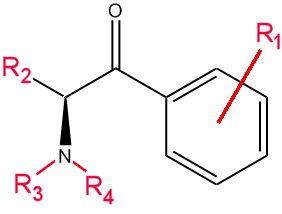
The various sidegroups that have been changed in cathinone to make new ‘designer’ drugs.
The R1 group can be in any one of the five positions on the ring.
Well, chemists changed the sidegroups R1-R4 shown in the diagram to a range of different substituents, including H, CH3, Et, Cl, F, and many more to create new molecules. For example, if you replace one H in the amine group (R3) with a methyl group, the new molecule is called methcathinone. This is an appetite suppressant, and has been used as an illegal performance enhancer in sport. Hundreds of these differently substituted cathinones ('designer drugs') started to appear on streets around the world from the mid-2000s.
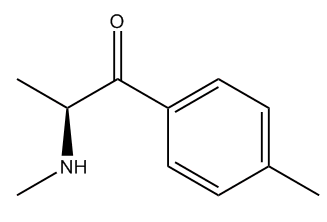 |
|
| Mephedrone |
Various governments around the world have tried to counteract this rapidly changing problem by banning whole classes of drug, rather than specific molecules. In the UK this came about in 2010 primarily to stop the sale of a derivative called mephedrone, known on the street as 4-MMC, M-CAT or meow meow. In this case, R1 = p-Me, R2 = Me, R3 = H and R4 = Me. Mephedrone and other cathinone derivatives used to be sold legally in high-street shops and on the internet, and were advertised as ‘legal highs’. But following rising public concern as a result of a number of high profile articles in the media and a rather sensationalised campaign by some newspapers, in 2010 they were classified as Class B drugs and are now illegal.
 |
Typical sensationalised media headlines from around 2009 promoting the mephedrone hysteria. |
 |
Its full name is methylenedioxy-α-pyrrolidinohexiophenone (or MDPHP). The structure is given below, and you can still see the cathinone skeleton within it in blue.
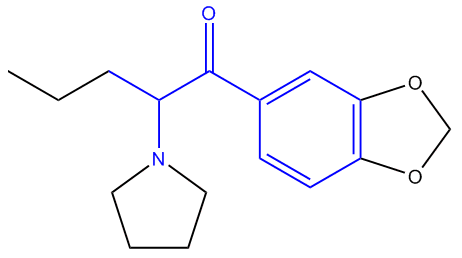 |
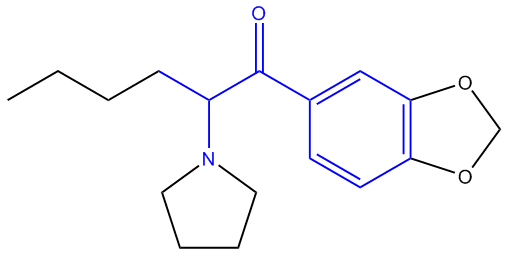 |
| 3,4-Methylenedioxypyrovalerone (MDPV) ‘Bath salts’ |
Methylenedioxy-α-pyrrolidinohexiophenone (MDPHP) ‘Monkey Dust’ |
MDPHP was first synthesised in 1960, but has recently become more widespread when it replaced the similar drug MDPV after that was banned. MDPV had already gained notoriety in the USA, where it went by the street name of “bath salts” (because its clumped white crystals resembled Epsom salts). The public began to become concerned about MDPV after a number of reported "cannibalism incidents". One of these was Rudy Eugene from Miami, who was shot by police while he was naked and chewing another person’s face. At the time it was believed that he was under the influence of the drug. But during his autopsy it was revealed that he'd had cannabis-induced psychosis instead - but by then the papers had reported it as another ‘bath salts’ attack. In another incident, an elderly woman was attacked with a shovel by a man claiming to be an alien talking to Jesus. As usual, the media revelled in these sensation stories, often without much concern as to whether they were actually true or not. |
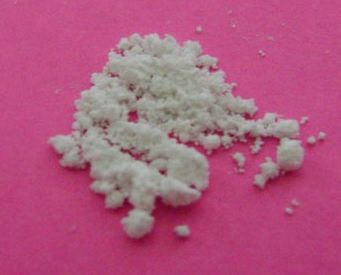 MDPV crystals resemble Bath salts. |
Well, there has been one police report linking use of MDPHP to this, as well as other less serious incidents such as it causing people to bite others and run into people's homes or into traffic. The drug can stop users feeling pain, and causes them to experience hallucinations - making them highly unpredictable. What makes it different to many other similar street drugs however, is that it is very cheap, only around £2 for a bag, and its effects can last for days. It is also addictive, and is becoming a big problem amongst the homeless people in certain parts of the UK and elsewhere.
So should we be worried?Not overly so. People need to be aware that the media love a good scare story, and will tend to exaggerate any sensational aspects of it to sell papers. And when politicians get involved in what looks like a good cause, scientific objectivity can disappear completely. Remember the Miami cannibal? It turns out he wasn't on bath salts after all. In the UK, one of the most widely reported 'mephedrone deaths' in 2009 was that of 14-year-old Gabrielle Price, who died allegedly after taking mephedrone. This made headline news, but later the results of toxicology tests showed the cause of her death was "cardiac arrest following broncho-pneumonia which resulted from streptococcal A infection", i.e. nothing to do with the drug. In November 2009, the Sun newspaper published a story with the headline: "Legal drug teen ripped his scrotum off". Its source was an internet blog, which was later found to be completely fictitious, posted as a joke by the blogger. Other newspaper reports stated that in a Leicestershire school 180 pupils had gone off sick as a result of legal highs. In actual fact, Leicestershire county council said there was no school at which 180 pupils had been off sick - due to legal highs or otherwise! So, again, it seems, the newspaper motto of "Don't let the facts get in the way of a good story" holds true. |
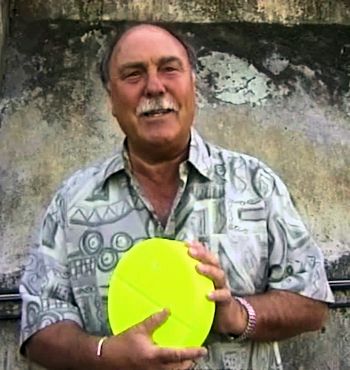 The footballer Jimmy Greaves appearing on Brass Eye with a giant yellow pill of the fake drug 'Cake' in 1997. |
This media hysteria is very reminiscent of a famous prank played by a UK comedian in the 1997 TV Show 'Brass Eye'. The host of this spoof documentary series, Chris Morris, tricked a bunch of famous celebrities into making videos warning the public of the dangers of a new designer drug called 'Cake'. This was repeatedly described to them as a 'totally made-up drug', which is a pretty strong hint that the drug was fake - but none of them guessed this. Moreover, it was said to originate from 'Czechoslovakia' - despite that country no longer existing at that time. Cake allegedly affected an area of the brain called "Shatner's Bassoon", while "massive water retention" caused the victims to have a bloated neck - called a "Czech neck". Morris even gave Cake other ludicrous (but plausible sounding) street names, like 'Basildon puke plates' and 'Loony toad quack'. It seems the well-meaning but gullible celebrities were only too willing to be fooled. Morris persuaded them to repeat horror stories about the 'drug', such as how taking Cake had made one girl 'throw up her own pelvis', and that 'one kiddy on Cake cried all the water out of his body. Just imagine how his mother felt!'. Even though this sounds ridiculous, it was so plausible that an MP even tabled a motion in the UK House of Commons to look into banning 'cake'!
History repeats itself. Despite the 'Cake' spoof, no lessons were learnt about the power of media hysteria. 10 years later the exact same hysteria happened for mephedrone. This time the drug was real, but many of the reports about it were wrong or grossly exaggerated. And now it's happening again with Monkey Dust. In an era of fake news, it is more important than ever that the general public have some degree of scientific reasoning to be able to tell what's real and what's hysterical hype.
![]()
![]()
![]() Back to Molecule of the Month page. [DOI:10.6084/m9.figshare.6984293]
Back to Molecule of the Month page. [DOI:10.6084/m9.figshare.6984293]